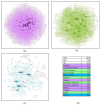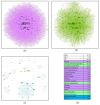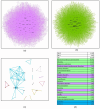Age-Related Variations and Seasonal Influences: A Network Analysis of Comorbidities in Asthma Hospitalizations (2013-2023)
- PMID: 40217800
- PMCID: PMC11989303
- DOI: 10.3390/jcm14072350
Age-Related Variations and Seasonal Influences: A Network Analysis of Comorbidities in Asthma Hospitalizations (2013-2023)
Abstract
Background: Asthma, a chronic respiratory disease characterized by airway inflammation and hyperresponsiveness, exhibits significant heterogeneity in its presentation. This study aimed to investigate age-related comorbidity patterns, seasonal variations, and demographic trends among a cohort of asthma patients within a defined geographical region. Methods: A retrospective analysis of 13,695 asthma patients admitted to a Romanian hospital from 2013 to 2023 was conducted. Comorbidity patterns were analyzed using network analysis across age groups, and seasonal trends were investigated through spectral analysis. Results: Asthma admissions exhibited non-linear trends with female predominance (57.72%). The pandemic significantly impacted admission rates, with males experiencing greater COVID-19-related effects. Female admissions showed distinct seasonal patterns potentially linked to domestic responsibilities. Comorbidity patterns evolved with age, shifting from lifestyle factors in younger patients to complex cardiovascular and neurological disorders in older groups. The 60-69 age group showed the highest integration of comorbidity communities. Conclusions: The study revealed that asthma management focus should shift with patient age from the disease itself to addressing underlying comorbidities. Understanding these complex patterns may help personalize treatment strategies and improve long-term prognosis for asthma patients.
Keywords: age-related patterns; asthma; comorbidities; complex network analysis; seasonal variations.
Conflict of interest statement
The authors declare no conflicts of interest. The funders had no role in the study’s design, in the collection, analyses, or interpretation of data, in the writing of the manuscript, or in the decision to publish the results.
Figures








Similar articles
-
Asthma hospitalization patterns in young children relating to admission age, infection presence, sex, and race.Ann Allergy Asthma Immunol. 2007 Feb;98(2):139-45. doi: 10.1016/S1081-1206(10)60686-2. Ann Allergy Asthma Immunol. 2007. PMID: 17304880
-
Time trends and seasonal variations in hospital admissions for childhood asthma in Taiwan from 1990 to 1998.Asian Pac J Allergy Immunol. 2001 Jun;19(2):63-8. Asian Pac J Allergy Immunol. 2001. PMID: 11699722
-
Using seasonal variations in asthma hospitalizations in children to predict hospitalization frequency.J Asthma. 2002 Oct;39(7):567-75. doi: 10.1081/jas-120014921. J Asthma. 2002. PMID: 12442946
-
Comparison of the seasonal patterns of asthma identified in general practitioner episodes, hospital admissions, and deaths.Thorax. 2000 Aug;55(8):662-5. doi: 10.1136/thorax.55.8.662. Thorax. 2000. PMID: 10899242 Free PMC article.
-
Tailored or adapted interventions for adults with chronic obstructive pulmonary disease and at least one other long-term condition: a mixed methods review.Cochrane Database Syst Rev. 2021 Jul 26;7(7):CD013384. doi: 10.1002/14651858.CD013384.pub2. Cochrane Database Syst Rev. 2021. PMID: 34309831 Free PMC article.
Cited by
-
Temporal Trends and Patient Stratification in Lung Cancer: A Comprehensive Clustering Analysis from Timis County, Romania.Cancers (Basel). 2025 Jul 10;17(14):2305. doi: 10.3390/cancers17142305. Cancers (Basel). 2025. PMID: 40723189 Free PMC article.
References
-
- GINA-2024-Strategy-Report-24_05_22_WMS.pdf [Internet] [(accessed on 8 December 2024)]. Available online: https://ginasthma.org/wp-content/uploads/2024/05/GINA-2024-Strategy-Repo....
-
- WHO Asthma [Internet] [(accessed on 8 December 2024)]. Available online: https://www.who.int/news-room/fact-sheets/detail/asthma.
-
- Finland: EU Country with Highest Share of Asthmatics [Internet] [(accessed on 12 January 2025)]. Available online: https://ec.europa.eu/eurostat/web/products-eurostat-news/-/edn-20210924-1.
Grants and funding
LinkOut - more resources
Full Text Sources

